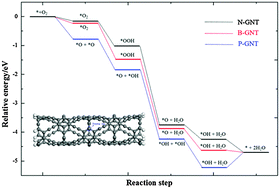Graphyne nanotubes as electrocatalysts for oxygen reduction reaction: the effect of doping elements on the catalytic mechanisms
Abstract
The detailed density functional theory (DFT) calculations have been carried out to study the oxygen reduction reaction (ORR) activity and the mechanism on doped single-walled γ-graphyne nanotubes (GNTs). Four of the most commonly used doping elements, N, B, P, and S atoms, were used to investigate the doping effects. The calculated results indicate that doping GNTs with different elements could lead to different ORR catalytic mechanisms. The ORR catalyzed by both N- and B-GNTs is initiated by the end-on adsorption of O2 and is completed via an O–H2O dissociation mechanism, while the ORR on the P-GNT is initiated by the bridge adsorption of O2 and is completed via an O2 dissociation mechanism. The predicted catalytic performance of the doped GNT would decrease in the sequence N-GNT > B-GNT > P-GNT > S-GNT, based on the analysis of adsorption energies of ORR species and landscapes of ORR pathways. Electronic structure analysis shows that the high ORR activity of doped GNTs is directly related to the suitable HOMO levels and HOMO–LUMO energy gaps.


 Please wait while we load your content...
Please wait while we load your content...